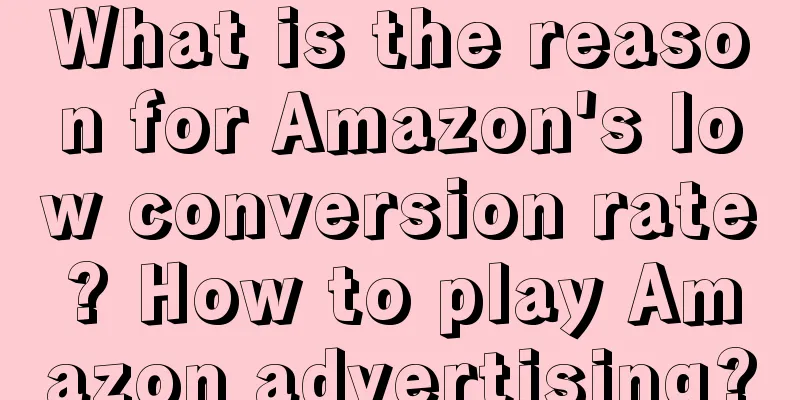What is the reason for Amazon's low conversion rate? How to play Amazon advertising?

|
After opening a store on Amazon, many merchants find that not only is it difficult to obtain traffic, but it is also difficult to increase the conversion rate of traffic. In fact, at this time, you should consider whether there is a problem with your promotion method, because promotion has an impact on the accuracy of traffic. Let’s talk about the possible reasons below. What’s the reason for Amazon’s low conversion rate? 1. Keyword research is too one-sided and negative keywords are ignored Hasty decision Keywords: Feedvisor attributes a large reason for poor ad performance to irrelevant keywords. Sellers need to choose specific keywords related to their products. The more specific the Amazon advertising keywords are, the more likely they are to help consumers find their desired products, thereby bringing high-value traffic to sellers. Ignore negative keywords: Negative keywords are likely to become a major competitive advantage for sellers when placing Amazon PPC (pay-per-click) ads. For sellers who choose negative keywords correctly, Amazon ads can reduce overall advertising costs without reducing exposure and conversion rates. What are the positions for Amazon ads? How to make Amazon ads rank higher? 2. Underutilizing or overusing automated campaigns Sellers should find a balance between overusing and underusing automatic campaigns, which should be used to collect data and keyword information that sellers can then use to adjust their manual campaigns to improve efficiency. Combining manual and automatic campaigns will ensure comprehensive coverage of relevant search queries; by using both advertising methods at the same time, Amazon Advertising sellers are more likely to discover keywords that are bringing conversions, as well as negative keywords that should be marked as "negative" because they either perform poorly or are irrelevant to the product, while also generating unnecessary PPC costs. How to Play Amazon Advertising? If played properly, in-site advertising can play a positive role in bringing in more traffic, generating more sales, and creating more profits. However, although many sellers know the advantages of in-site PPC, they cannot achieve the expected results in actual applications, resulting in an uneconomical advertising input-output ratio. 1. There are three purposes for placing on-site PPC ads: to attract traffic, increase sales, and create profits. Although these three aspects interact with each other, the purpose and focus of advertising are different at different stages. In the first stage of advertising, traffic should be the main goal. For e-commerce sellers, the amount of traffic largely determines all subsequent operational behaviors. Therefore, during the advertising process at this stage, sellers can focus on the traffic brought by the advertising. From the advertising data report, impressions (Impression) and clicks (Clicks) are data that need special attention, but advertising is a gradual process, and so is the growth of exposure and traffic. 2. Generally speaking, in the early stage of advertising, the exposure and click volume will not be too high, but as the listing details and advertising keyword data are captured by the system, the exposure begins to increase. Therefore, sellers need to have a certain observation period in the early stage of advertising. If the exposure of the ad is still low after running for a period of time, the seller needs to consider whether it is due to too low an ad bid or too little budget. After verification, the bid and daily budget should be appropriately increased. As the ad runs, when there is a certain amount of exposure and clicks (traffic), the seller needs to pay attention to its conversion rate, that is, the number of orders brought by the ad. At this level, we can first pay attention to the specific number of orders (amount) brought by the ad, and also pay attention to the changes in the ACOS data in the ad report. 3. Usually, as orders increase from zero to more, the ACOS value also decreases from high to low, showing a trend of gradual decrease. If the data of the advertisement feedback is like this, such advertisements are worth continued attention. Of course, at this stage, in order to make the overall performance of the advertisement better, sellers can strategically improve the advertisement conversion rate (CTR and CR) by lowering the product price and using advertisements to increase orders. Such operations can also make the advertisement perform better to a certain extent. If the traffic conversion rate of Amazon stores is low, you can try to make the traffic more precise, such as managing the store’s crowd tags, choosing tools that can accurately calculate traffic during promotion, etc. Because Amazon’s sites are different and the market characteristics may also be different, you must do a good job of advance research. Recommended reading: Is it profitable to open a cross-border e-commerce store on Amazon? How can individuals do well on Amazon? What products are suitable for Amazon? What products are easy to sell? Where can I view my Amazon bill? Where can I view my income? |
<<: How to cancel Amazon Global Selling? How to close it?
>>: Does Amazon FBA need to pay taxes? Detailed answer
Recommend
Improve conversion rate by 90% and build a private domain label system from 0 to 1
With the development of science and technology, Ch...
With 17 million fans, middle-aged and elderly people also love to "chase stars"
A piece of social news one month ago made a Douyin...
How effective is Shopee live streaming? How to enable live streaming?
Speaking of Shopee, it is very popular nowadays. I...
How to open your own store on Amazon? How to do cross-border e-commerce at home?
Amazon is one of the largest e-commerce platforms ...
Make a good VLog of women's life and earn 50,000 yuan a month
Do you want to make money easily by shooting video...
How to grow private domain activities like a "big company"
To achieve growth, you need not only a global pers...
Where can I find Amazon's conversion rate? How can I increase Amazon's conversion rate?
The conversion rate of a store is an important fac...
New retail has fallen in eight years, and platform business is returning to its essence
Exploring new traffic is the key starting point of...
Brands should focus on "behavior"
Brand plays an important role in consumers' de...
What are the overseas shopping websites? Website introduction
There are domestic shopping websites in China, and...
Get rid of the homogeneity of Xiaohongshu content! Based on the crowd + pain points, 13 content directions are derived to create a hot selling article in one go!
This article will explore in depth how Chuangfukan...
Product Marketing Revelation: Hangzhou Asian Games from Different Perspectives
The two-week-long Hangzhou Asian Games is coming t...
What are the methods for promoting adult products on Amazon? How to do it?
There are some merchants on the Amazon platform wh...
Mixue Ice City, disrupting music festival marketing again
Mixue Ice City announced that it would launch an &...
Do I need to do customs clearance for items I buy from eBay? How much does it cost to do customs clearance for goods worth 3,000 yuan?
As one of the world's largest online shopping ...









